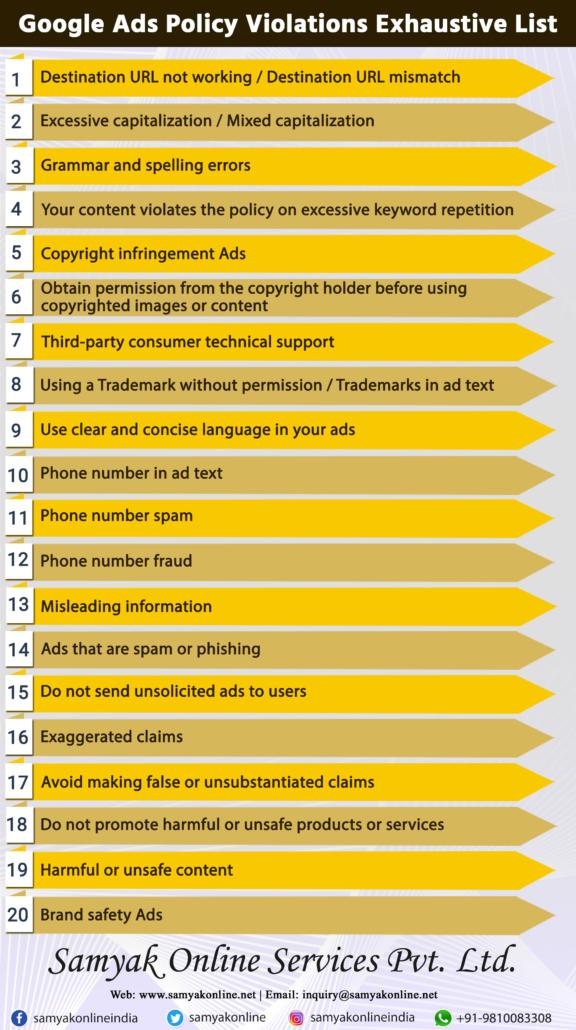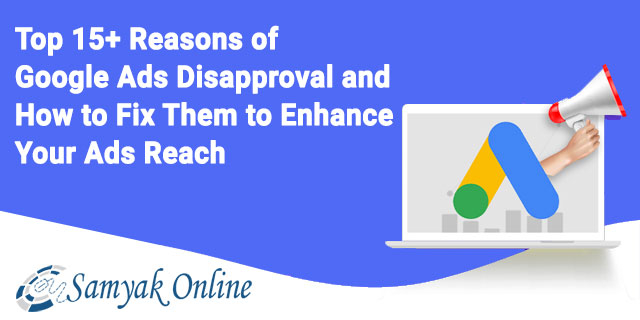Top 15+ Reasons of Google Ads Disapproval and How to Fix Them to Enhance Your Ads Reach
Last Updated on April 3, 2024 by Subhash Jain
Google advertisers often experience the disapproval of their ads due to violation of Google Ads Policies. Whether it is impacting the expected results of your new campaign or reducing the performance of an ongoing Google Ads campaign, the sight of red text in the status column is frustrating for every advertiser, and everyone wants it to disappear as soon as possible. But how can you make that happen? Google’s 2022 Ads Safety Report provides insights into the various reasons that lead to Google Ads disapproval. In this blog, I will list 15+ reasons for Google Ads disapproval based on the findings of the 2022 Ads Safety Report. By addressing these reasons, you can improve the outcome of your Google Ads campaign and achieve the best return on investment (ROI).”
What is Google Ads Safety Reports?
“In 2022, we removed over 5.2 billion ads, restricted over 4.3 billion ads and suspended over 6.7 million advertiser accounts. This represents an increase of 2 billion more ads removed in 2022 from the previous year. We also blocked or restricted ads from serving on over 1.5 billion publisher pages and took broader site-level enforcement action on over 143,000 publisher sites. To enforce our policies at this scale, we rely on a combination of human reviews and automated systems powered by artificial intelligence and machine learning. This helps sort through content and better detect violations across the globe.” Google Ads Safety Reports.
Are you also experiencing an increase in Google Ads disapproval for your Ads campaign? Do you want to make sure that you get the maximum ROI of Google Ads at the earliest without attracting any penultimate action enforced by Google Ads policies? Go through the following 15+ hacks to run your Google Ads campaign successfully.

Destination URL
The Destination URL Policy ensures that users, by clicking on an ad, land on relevant, functional, easy-to-navigate, and useful pages, providing them with a good experience with the particular brand. The possible errors under this category include an unacceptable destination that is not working, destination mismatch, not crawlable destination, and not accessible destination, among others. The hack to fix the ‘destination URL’ issue is to identify the error, understand the error, and verify the ad URL using Chrome DevTools.
Ads Not Complying with Google Ads Editorial Policy
This policy ensures high professional and editorial standards for ads, assets, and destinations. Disapproval under this clause can occur due to the unacceptable use of spacing, repetition, capitalization, punctuation, symbols, image quality, unidentified business, phone numbers in text, and more. The hack to fix the destination error is to review your ad text and assets, identify any possible errors, and correct them.
Engagement in Dishonest or Fraudulent Behavior
Ads promoting dishonest behavior or encouraging users to mislead others are disapproved. If your advertised products or services encourage unauthorized access to others’ property/system/device or monitoring of another person’s activities, your Google Ad will receive a warning before being disapproved. The hack to fix the ‘dishonest or fraudulent behavior’ issue is to either edit the content according to the standard policy or appeal a policy decision.
Advertising of Dangerous or Prohibited Products or Services
Google prohibits the advertising of products or services that may cause harm, injury, or damage to users, such as explosives, guns/parts, and weapons. The hack to fix the ‘dangerous or prohibited products’ issue is to refer to this video.
Misleading or Deceptive Ad Content
Google aims to strengthen the trust of Google Ads users by enforcing policies against deceptive ad content. Advertisers are guided to provide correct and relevant information that helps users make well-informed buying decisions. Practices such as scamming, phishing, misleading representation, wrong pricing practices, and clickbait tactics are strictly prohibited. The hack to fix the ‘deceptive ad content’ issue is to act swiftly upon receiving a warning email. Review and edit payment models, billing information, ad destinations, and provided information to make your Google Ads more trustworthy.”
Detection of Malicious Software or Malware
If Google’s crawler identifies any suspicious activity on the linked website, the ad is disapproved. The hack to fix the ‘Malicious Software Or Malware’ issue is to ask your webmaster to check coding to detect and fix any suspicious activity or you can ask Google to get clarification.
Disapprovals Specific to Certain Industries or Sectors
Google Ads disapproval policy restricts certain business types from advertising promoting products or services categorised as abuse posing a risk to user experience and safety. For example- bail bonds services, promotion of call directory, and technical support by third-party vendors. The hack to fix the ‘industry or sector’ issue is to alter the text to make it suitable for an appropriate business category. For example, Google Ad for technical support by third-party vendors can be placed under ITSM services.
Inclusion of Phone Numbers In Ad Text
If the headline or description of ad has a phone number, you are sure to get disapproval. The hack to fix the ‘phone numbers in ad text’ issue is to use call extensions or call ads.
Non-Compliance with Regulations for Content Targeting Children
Ads designed with content themed for ‘made for kids’ that seem unfair, inappropriate, or deceptive for the target audience get disapproval. Ads with violent graphic content, scary imagery, skin exposure, and crude humor not suitable for children are prohibited. The hack to fix the ‘content targeting children’ issue is to review the policy and watch this video to act accordingly.
Approval Granted With Certain Limitations or Restrictions
Google Ads disapproval policy is sensitive to legally or culturally sensitive content. If the served information is judged inappropriate in any context, advertisers need additional requirements. The content related to gambling, healthcare and medicines, political content, financial products, trademarks, etc needs extra clearance from the authorities for the ad display in a particular area and period. The hack to fix the ‘certain limitations or restrictions’ issue is to check the content; it should not be impacting the behavior of users as well as it should be well in line with local applicable laws and regulations.
Insufficient Information or Documentation
The new Google Ads disapproval policy makes sure that users get the relevant and complete information as per their objectives and interest. The replicated content or excessive advertising or content having no value informative and functional values, or content created to drift users elsewhere gets disapproval. The hack to fix the ‘insufficient information or documentation’ issue is to check and optimize ad destination, content values, relevance, and content quality.
Violation of Personalized Advertising Policies
Personalized advertising effectively improves ROI for advertisers. Google Ads promoting sensitive interest categories like sexual interests, systemic discrimination, personal hardships, legal restrictions, etc get disapproval. Advertisers promoting products and services under users’ sensitive interest categories are not eligible to use certain targeting features. The hack to fix the ‘personalized advertising’ issue is to read the policy carefully and Remove the objectionable content from ad text.
Invalid or Suspicious Click Activity
Google uses AI/ML systems, sophisticated filters, and human reviews both to analyze the pattern of ad clicks and impressions for avoiding invalid traffic that causes artificial increases publisher’s earnings and advertiser’s costs. The hack to fix the ‘suspicious click activity’ issue is to review the traffic and ad implementations to ensure that you are not getting traffic from an unreliable source; terminate association with low-quality and untrustworthy parties; and, don’t click your ad frequently.
Multiple Account Policy Violations
According to Google’s Ads disapproval policy, one business can run its ads only through one account; running ads for the same business from multiple accounts will disapprove your ad. The hack to fix ‘Multiple Account Issue’ is to act swiftly according to the warning rather than opening a new account.
Non-Payment or Billing Issue
Even if you have one due balance for running ads, you can get advertisement suspension. Hack to fix the ‘Non-Payment or Billing Issue’ is to make payment as per dues.
Circumventing Systems
Violation of the advertising norms prohibits users having perceived intention of exploiting Google’s systems and policies. The penalty may be in different forms like preventing new content development, running ad, and suspension of associated accounts/ merchant center accounts. The hack to fix the ‘Circumventing Systems’ issue is the identify the prohibited or trademarked word/s and edit the assets and ad text; send the request to resolve the issue.
FAQs
There are many reasons why your Google Ads ad might have been disapproved. Some of the most common reasons include:
* The ad violates Google’s advertising policies.
* The ad is not relevant to the search terms that users are using.
* The ad is not well-written or does not follow Google’s ad guidelines.
* The ad is not targeting the right audience.
To fix a disapproved Google Ads ad, you will need to identify the reason for the disapproval and make the necessary changes to the ad. Once you have made the changes, you can submit the ad for review again.
To prevent your Google Ads ads from being disapproved in the future, you can follow these tips:
* Make sure your ads are relevant to the search terms that users are using.
* Write your ads clearly and concisely, and follow Google’s ad guidelines.
* Target your ads to the right audience.
Pro-Tip
The Google Ads API is a programmatic interface that allows Google Ads designers and developers to interact with the Google Ads platform, resulting in increased efficiency and accuracy in managing Google Ads campaigns and accounts. Additionally, the v202305 release of the Google Ad Manager API on Wednesday, May 24, 2023, provides valuable support for ad managers to build applications for easy reporting, inventory management, forecasting, and more. Another useful tool to help manage Google Ads campaigns and avoid disapprovals is the ‘Disapproved Ads Auditor’.
About Author
Subhash Jain is the Founder of Samyak Online – Your trusted partner for Google Ads Management. Don’t miss out on the opportunity to maximize your Google Ads spend. Reach out to us and we’ll show you how.


Leave a Reply
Want to join the discussion?Feel free to contribute!